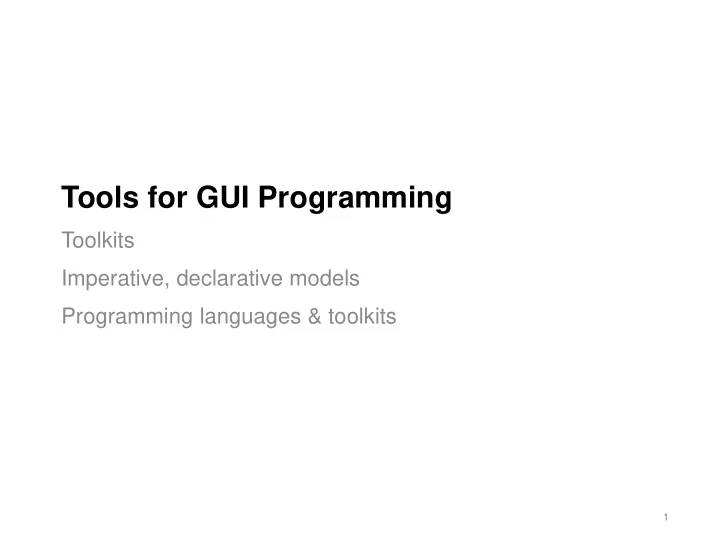

Tools for GUI Programming Toolkits Imperative, declarative models Programming languages & toolkits 1
GUI Toolkits Operating systems (and windowing systems) include basic capabilities for input , output , and window management ( see previous lecture ). We often want a higher level of abstraction, or more capabilities than the base OS provides. - Classes that hide the underlying implementation - Wrappers to make the underlying functionality compatible with a particular programming language A toolkit is set of reusable classes or components for building applications. - Can be provided by OS vendors, programming language vendors, other sources. - Usually specific to a programming language + platform 2
What functionality does a toolkit provide? Toolkit are delivered as libraries that provide useful capabilities for handling: Output - Drawing graphics primitives (e.g. shapes, images). - Animating shapes, windows. - Video and animation playback. Input - Standard input (e.g. keyboard, mouse) - Camera, sensors etc. Also, they often provide UI components or widgets that can be reused in any application (which we will discuss soon). Widgets (Qt) 3
Types of Toolkits 1. Low-level toolkits - build into, or tightly integrated with, the underlying operating system (also called “native” or “heavyweight”). - e.g. Win32 on Windows, Cocoa on macOS, Xlib on Unix. 2. High-level toolkits - sit “above” the operating system, with no tight integration (“third - party” since they are not provided by OS vendor). - also called “lightweight” since they’re not tightly coupled. - may or may not have a “native” look -and-feel for a platform. - e.g. Qt, Gtk+, wxWidgets, Swing, JavaFX, MFC, WTL. 4
Examples of Toolkits Desktop : platform- specific language + toolkit combination (“low - level”) Windows: UWP, WPF, Windows Forms, Win32 -- using C++ or C# Mac: Cocoa -- Swift or Objective C Linux: Gtk -- C ++ Cross-Platform : toolkit can be deployed to multiple platforms (“high - level”). Java Swing, JavaFX -- Java or Kotlin wxWidgets – C++, Python, Perl Qt -- C++, Java, Python Tk -- Tk and Python https://en.wikipedia.org/wiki/List_of_widget_toolkits 5
Choosing Programming Language + Toolkit You often have to consider multiple dimensions when deciding which technology stack to use for your application. Platform : which operating systems do you wish to support (e.g. Windows, Mac, Linux, iOS, Android)? Programming Language : which programming language for building your application? Toolkit : which toolkit works on platform + language, and provides the capabilities that you need. Vendors (Microsoft, Apple) are typically focused on promoting their own platform, less interested in other platforms. They typically provide libraries and support for their “favored” programming language (e.g. Swift on macOS, Java on Android). Cross- platform tools are rare (“holy grail” of UI development). 6
How to build a User Interface? After you’ve picked a set of technologies (programming language + toolkit), how do you use them to write code for interactive applications? Two main approaches: Imperative : the user-interface is manually constructed in code 1. Also called procedural . - The “traditional” approach, which treats the UI as a library to - manipulate in code. Declarative : separation between the layout and the code. 2. Often layout is described in a human-readable layout file. The - toolkit has support for loading the layout file and applying it. Layout can be compiled into a resource file (e.g. Objective C, - NIB), or dynamically interpreted (e.g. HTML/CSS). 7
Imperative Programming Code is used to manually construct the view. Everything is manually controlled. Virtually every programming environment offers some ability to do this (e.g. Java/Swing, C++/Qt, Python, Javascript/HTML). Python w. Qt toolkit Benefits: - You have complete control over how objects are created and managed. Drawbacks - Requires programming knowledge to create or change. - It’s tedious to build a UI in this fashion! 8
Declarative (Markup) The programmer (or designer) uses some markup language to describe how the View should be constructed. - e.g. XML At runtime, code “automatically” loads in this markup declaration and uses it to instantiate code. - e.g. Layout files on Android, Java FX. Android GUI builder and Layout Benefits: - Non-programmers can work with it. - Human- readable, and “easy” to read. - Supports GUI builders (drag-drop) Drawbacks: - Syntax can be messy - Practically requires tools to generate. 9 Visual Basic GUI Builder
Declarative (Drag-and-Drop) The programmer uses a tool to build the UI and associates code with elements in the UI. Format is generally not human-readable aka binary . But not for every toolkit (e.g. JavaFx) Used to be common, but the lack of visibility into the GUI code limits it. E.g. Visual Basic, Delphi. • Benefits: Non-programmers can use it. - Supports GUI builders. - • Drawbacks: Requires proprietary tools to - Visual Basic GUI Builder generate or modify to the UI. Binary - > can’t diff the UI code! - 10
Course Goals: Why Java? Cross-platform - Target desktop (Win/Mac/Linux) + mobile (Android) - Dev tools support: Windows, Mac, Linux - Able to code + build + test on your own machine Robust language + framework - Support a range of applications, incl. graphics - Extensive libraries/frameworks, good tools support - Not going to be replaced anytime soon Imperative + Declarative Demonstrates best-practices - Reflects how we want to teach UI design and development 11
Java GUI Toolkits Toolkit Description • AWT Low- level or “heavyweight”, used platform - specific widgets. • AWT applications were limited to common- functionality that existed on all platforms. • Swing High- level or “lightweight”, full widget implementation using imperative model. • Commonly used and deployed cross-platform. • Standard Window ”Heavyweight” hybrid model: native, and tied to Toolkit / SWT specific platform (Windows). • Used in Eclipse. • Java FX Intended for rich desktop + mobile apps. • Declarative programming model, designed to replace Swing. 12
Recommend
More recommend